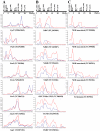Consequences of C4 differentiation for chloroplast membrane proteomes in maize mesophyll and bundle sheath cells
- PMID: 18453340
- PMCID: PMC2556027
- DOI: 10.1074/mcp.M800016-MCP200
Consequences of C4 differentiation for chloroplast membrane proteomes in maize mesophyll and bundle sheath cells
Abstract
Chloroplasts of maize leaves differentiate into specific bundle sheath (BS) and mesophyll (M) types to accommodate C(4) photosynthesis. Chloroplasts contain thylakoid and envelope membranes that contain the photosynthetic machineries and transporters but also proteins involved in e.g. protein homeostasis. These chloroplast membranes must be specialized within each cell type to accommodate C(4) photosynthesis and regulate metabolic fluxes and activities. This quantitative study determined the differentiated state of BS and M chloroplast thylakoid and envelope membrane proteomes and their oligomeric states using innovative gel-based and mass spectrometry-based protein quantifications. This included native gels, iTRAQ, and label-free quantification using an LTQ-Orbitrap. Subunits of Photosystems I and II, the cytochrome b(6)f, and ATP synthase complexes showed average BS/M accumulation ratios of 1.6, 0.45, 1.0, and 1.33, respectively, whereas ratios for the light-harvesting complex I and II families were 1.72 and 0.68, respectively. A 1000-kDa BS-specific NAD(P)H dehydrogenase complex with associated proteins of unknown function containing more than 15 proteins was observed; we speculate that this novel complex possibly functions in inorganic carbon concentration when carboxylation rates by ribulose-bisphosphate carboxylase/oxygenase are lower than decarboxylation rates by malic enzyme. Differential accumulation of thylakoid proteases (Egy and DegP), state transition kinases (STN7,8), and Photosystem I and II assembly factors was observed, suggesting that cell-specific photosynthetic electron transport depends on post-translational regulatory mechanisms. BS/M ratios for inner envelope transporters phosphoenolpyruvate/P(i) translocator, Dit1, Dit2, and Mex1 were determined and reflect metabolic fluxes in carbon metabolism. A wide variety of hundreds of other proteins showed differential BS/M accumulation. Mass spectral information and functional annotations are available through the Plant Proteome Database. These data are integrated with previous data, resulting in a model for C(4) photosynthesis, thereby providing new rationales for metabolic engineering of C(4) pathways and targeted analysis of genetic networks that coordinate C(4) differentiation.
Figures






Similar articles
-
Studies of the Ndh complex and photosystem II from mesophyll and bundle sheath chloroplasts of the C4-type plant Zea mays.J Plant Physiol. 2006 Jul;163(8):800-8. doi: 10.1016/j.jplph.2005.11.014. Epub 2006 Jan 24. J Plant Physiol. 2006. PMID: 16436305
-
Reconstruction of metabolic pathways, protein expression, and homeostasis machineries across maize bundle sheath and mesophyll chloroplasts: large-scale quantitative proteomics using the first maize genome assembly.Plant Physiol. 2010 Mar;152(3):1219-50. doi: 10.1104/pp.109.152694. Epub 2010 Jan 20. Plant Physiol. 2010. PMID: 20089766 Free PMC article.
-
Cytological evidence of BSD2 functioning in both chloroplast division and dimorphic chloroplast formation in maize leaves.BMC Plant Biol. 2020 Jan 9;20(1):17. doi: 10.1186/s12870-019-2219-7. BMC Plant Biol. 2020. PMID: 31918680 Free PMC article.
-
How to build functional thylakoid membranes: from plastid transcription to protein complex assembly.Planta. 2013 Feb;237(2):413-28. doi: 10.1007/s00425-012-1752-5. Epub 2012 Sep 14. Planta. 2013. PMID: 22976450 Free PMC article. Review.
-
Molecular recognition in thylakoid structure and function.Trends Plant Sci. 2001 Jul;6(7):317-26. doi: 10.1016/s1360-1385(01)02010-6. Trends Plant Sci. 2001. PMID: 11435171 Review.
Cited by
-
Setaria viridis: a model for C4 photosynthesis.Plant Cell. 2010 Aug;22(8):2537-44. doi: 10.1105/tpc.110.075309. Epub 2010 Aug 6. Plant Cell. 2010. PMID: 20693355 Free PMC article.
-
The importance of energy balance in improving photosynthetic productivity.Plant Physiol. 2011 Jan;155(1):70-8. doi: 10.1104/pp.110.166652. Epub 2010 Nov 15. Plant Physiol. 2011. PMID: 21078862 Free PMC article. Review. No abstract available.
-
Elements required for an efficient NADP-malic enzyme type C4 photosynthesis.Plant Physiol. 2014 Apr;164(4):2231-46. doi: 10.1104/pp.113.230284. Epub 2014 Feb 12. Plant Physiol. 2014. PMID: 24521879 Free PMC article.
-
Efficient operation of NAD(P)H dehydrogenase requires supercomplex formation with photosystem I via minor LHCI in Arabidopsis.Plant Cell. 2009 Nov;21(11):3623-40. doi: 10.1105/tpc.109.068791. Epub 2009 Nov 10. Plant Cell. 2009. PMID: 19903870 Free PMC article.
-
The developmental dynamics of the maize leaf transcriptome.Nat Genet. 2010 Dec;42(12):1060-7. doi: 10.1038/ng.703. Epub 2010 Oct 31. Nat Genet. 2010. PMID: 21037569
References
-
- Sheen, J. ( 1999) C-4 gene expression. Annu. Rev. Plant Physiol. Plant Mol. Biol. 50, 187–217 - PubMed
MeSH terms
Substances
LinkOut - more resources
Full Text Sources
Miscellaneous

